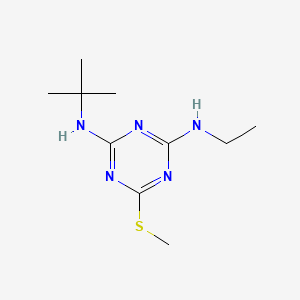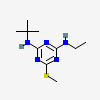Terbutryn
- Terbutryn
- 886-50-0
- TERBUTRYNE
- Clarosan
- Shortstop
- Create:2004-09-16
- Modify:2025-01-18

- 2-(tert-butylamino)-4-(ethylamino)-6-(methylthio)-s-triazine
- 2-ethylamino-6-methylthio-4-tert-butylamino-1,3, 5-triazine
- Clarosan
- terbutrin
- terbutryn
- terbutryne
- Terbutryn
- 886-50-0
- TERBUTRYNE
- Clarosan
- Shortstop
- Igran
- Prebane
- Terbutrex
- Saterb
- Igran 50
- Short-stop E
- N2-(tert-Butyl)-N4-ethyl-6-(methylthio)-1,3,5-triazine-2,4-diamine
- Terbutrin
- Caswell No. 125D
- Igran 500
- Terbutryn [ISO]
- Terbutryne [ISO-French]
- Terbutryn [ANSI:BSI:ISO]
- Athado
- HSDB 1525
- UNII-ZXL474TLFP
- 1,3,5-Triazine-2,4-diamine, N-(1,1-dimethylethyl)-N'-ethyl-6-(methylthio)-
- EINECS 212-950-5
- 1,3,5-Triazine-2,4-diamine,N-(1,1-dimethylethyl)-N'-ethyl-6-(methylthio)-
- N-(1,1-Dimethylethyl)-N'-ethyl-6-(methylthio)-1,3,5-triazine-2,4-diamine
- EPA Pesticide Chemical Code 080813
- Amigan (Salt/Mix)
- BRN 0611817
- DTXSID3024318
- GS 14260
- HS-14260
- CHEBI:44156
- TERBUTRYN [HSDB]
- 2-T-BUTYLAMINO-4-ETHYLAMINO-6-METHYLTHIO-S-TRIAZINE
- 2-tert-Butylamino-4-ethylamino-6-methylthio-1,3,5-triazine
- A 1866
- ZXL474TLFP
- s-Triazine, 2-(tert-butylamino)-4-(ethylamino)-6-(methylthio)-
- 2-Methylthio-4-ethylamino-6-tert-butylamino-s-triazine
- 2-tert-Butylamino-4-ethylamino-6-methylthio-s-triazine
- DTXCID504318
- 2-tert-Butylamino-4-ethylamino-6-methylmercapto-s-triazine
- N2-tert-Butyl-N4-ethyl-6-methylthio-1,3,5-triazine-2,4-diamine
- 2-N-tert-butyl-4-N-ethyl-6-methylsulfanyl-1,3,5-triazine-2,4-diamine
- 4-Aethylamino-2-tert-butylamino-6-methylthio-s-triazin
- 2-(tert-butylamino)-4-(ethylamino)-6-(methylthio)triazine
- 2-tert.Butylamino-4-aethylamino-6-methylthio-1,3,5-triazin
- 2-(tert-butylamino)-4-(ethylamino)-6-(methylthio)-s-triazine
- Terbutryne (ISO-French)
- N-(tert-butyl)-N'-ethyl-6-(methylthio)-1,3,5-triazine-2,4-diamine
- Terbutryn (ANSI:BSI:ISO)
- 2-tert-butylamino-4-ethylamino-6-methylthio-[1,3,5]triazine
- 2-Tert.-butylamino-4-ethylamino-6-methylthio-[1,3,5]triazin
- 2-Tert.-butylamino-4-ethylamino-6-methylthio-[1,3,5]triazine
- N(2)-tert-butyl-N(4)-ethyl-6-methylthio-1,3,5-triazine-2,4-diamine
- N2-tert-butyl-N4-ethyl-6-(methylthio)-1,3,5-triazine-2,4-diamine
- N-(tert-butyl)-N'-ethyl-6-(methylsulfanyl)-1,3,5-triazine-2,4-diamine
- N(SUP 2)-TERT-BUTYL-N(SUP 4)-ETHYL-6-METHYLTHIO-1,3,5-TRIAZINE-2,4-DIAMINE
- CAS-886-50-0
- Plantonit
- 2-Tert-butylamino-4-ethylamino-6-methylthio-(1,3,5)triazine
- 2-Tert.-butylamino-4-ethylamino-6-methylthio-(1,3,5)triazin
- 2-Tert.-butylamino-4-ethylamino-6-methylthio-(1,3,5)triazine
- Shortstop E
- MFCD00128025
- Terbutryn (Standard)
- Igran 80W
- Terbutryn 10 microg/mL in Cyclohexane
- Terbutryn 10 microg/mL in Acetonitrile
- Caswell No 125 D
- Terbutryn 100 microg/mL in Acetonitrile
- N-tert-Butyl-N-ethyl-6-methylthio-1,3,5-triazine-2,4-diamine
- 4-Aethylamino-2-tert-butylamino-6-methylthio-s-triazin [German]
- 2-tert.Butylamino-4-aethylamino-6-methylthio-1,3,5-triazin [German]
- Oprea1_587742
- SCHEMBL65395
- MLS001066371
- Terbutryn, analytical standard
- CHEMBL1234490
- SCHEMBL20893401
- HY-B1991R
- EX-A928
- 2-ethylamino-6-methylthio-4-tert-butylamino-1,3, 5-triazine
- HMS2236M08
- HMS3370H22
- HY-B1991
- Tox21_202082
- Tox21_303141
- N2-tert-butyl-N4-ethyl-6-methylsulfanyl-1,3,5-triazine-2,4-diamine
- AKOS015907183
- CS-5180
- DB08215
- HS14260
- N-(1,1-Dimethylethyl)-N'-ethyl-6-(methylthio)-1,3,5-triazine-2,4-diamine (9CI)
- USEPA/OPP Pesticide Code: 080813
- NCGC00164299-01
- NCGC00164299-02
- NCGC00257200-01
- NCGC00259631-01
- 1ST22213
- AS-76304
- SMR000471867
- DB-057093
- 2Methylthio4ethylamino6tertbutylaminostriazine
- 2tertButylamino4ethylamino6methylthiostriazine
- 4Aethylamino2tertbutylamino6methylthiostriazin
- NS00000276
- Terbutryn, PESTANAL(R), analytical standard
- Butylamino-4-ethylamino-6-methylthio-s-triazine
- C18811
- 2tertButylamino4ethylamino6methylmercaptostriazine
- 2tertButylamino4ethylamino6methylthio1,3,5triazine
- A842816
- 2tert.Butylamino4aethylamino6methylthio1,3,5triazin
- Methylthio-4-ethylamino-6-tert-butylamino-s-triazine
- NtertButylNethyl6methylthio1,3,5triazine2,4diamine
- Q2404338
- W-100395
- N2tertButylN4ethyl6methylthio1,3,5triazine2,4diamine
- sTriazine, 2(tertbutylamino)4(ethylamino)6(methylthio)
- 1,3,5Triazine2,4diamine, N(1,1dimethylethyl)N'ethyl6(methylthio)
- N(1,1Dimethylethyl)N'ethyl6(methylthio)1,3,5triazine2,4diamine
- N-tert-Butyl-N'-ethyl-6-(methylthio)-1,3,5-triaZine-2,4-diamine
- 2,4-Diamine-N-(1,1-dimethylethyl)-N'-ethyl-6-(methylthio)triazine,
- N(1,1Dimethylethyl)N'ethyl6(methylthio)1,3,5triazine2,4diamine (9CI)
- N-tert-butyl-N'-ethyl-6-(methylsulfanyl)-1,3,5-triazine-2,4-diamine
186.081 100
242.144 19.27
158.0495 1.58
91.0324 1.57
68.0243 100
85.0509 32.78
158.0495 26.79
74.0058 26.72
116.0277 24.39
242.1435 999
186.0802 223
187.0822 15
188.0757 7
186.0815 999
242.1435 665
187.0825 158
243.1459 51
158.0485 21
186.11901 100
198.04149 46.49
167.14993 33.92
68.13357 28.81
29.13347 28.65


H302 (49.8%): Harmful if swallowed [Warning Acute toxicity, oral]
H317 (57.5%): May cause an allergic skin reaction [Warning Sensitization, Skin]
H319 (12%): Causes serious eye irritation [Warning Serious eye damage/eye irritation]
H332 (11.4%): Harmful if inhaled [Warning Acute toxicity, inhalation]
H400 (95.7%): Very toxic to aquatic life [Warning Hazardous to the aquatic environment, acute hazard]
H410 (85.8%): Very toxic to aquatic life with long lasting effects [Warning Hazardous to the aquatic environment, long-term hazard]
P261, P264, P264+P265, P270, P271, P272, P273, P280, P301+P317, P302+P352, P304+P340, P305+P351+P338, P317, P321, P330, P333+P317, P337+P317, P362+P364, P391, and P501
(The corresponding statement to each P-code can be found at the GHS Classification page.)
Aggregated GHS information provided per 325 reports by companies from 21 notifications to the ECHA C&L Inventory. Each notification may be associated with multiple companies.
Reported as not meeting GHS hazard criteria per 5 of 325 reports by companies. For more detailed information, please visit ECHA C&L website.
There are 20 notifications provided by 320 of 325 reports by companies with hazard statement code(s).
Information may vary between notifications depending on impurities, additives, and other factors. The percentage value in parenthesis indicates the notified classification ratio from companies that provide hazard codes. Only hazard codes with percentage values above 10% are shown.
Acute Tox. 4 (49.8%)
Skin Sens. 1 (57.5%)
Eye Irrit. 2 (12%)
Acute Tox. 4 (11.4%)
Aquatic Acute 1 (95.7%)
Aquatic Chronic 1 (85.8%)
Patents are available for this chemical structure:
https://patentscope.wipo.int/search/en/result.jsf?inchikey=IROINLKCQGIITA-UHFFFAOYSA-N
- Australian Industrial Chemicals Introduction Scheme (AICIS)1,3,5-Triazine-2,4-diamine, N-(1,1-dimethylethyl)-N'-ethyl-6-(methylthio)-https://services.industrialchemicals.gov.au/search-inventory/
- CAS Common ChemistryLICENSEThe data from CAS Common Chemistry is provided under a CC-BY-NC 4.0 license, unless otherwise stated.https://creativecommons.org/licenses/by-nc/4.0/
- ChemIDplusTerbutryn [ANSI:BSI:ISO]https://pubchem.ncbi.nlm.nih.gov/substance/?source=chemidplus&sourceid=0000886500ChemIDplus Chemical Information Classificationhttps://pubchem.ncbi.nlm.nih.gov/source/ChemIDplus
- DrugBankLICENSECreative Common's Attribution-NonCommercial 4.0 International License (http://creativecommons.org/licenses/by-nc/4.0/legalcode)https://www.drugbank.ca/legal/terms_of_use
- EPA DSSToxCompTox Chemicals Dashboard Chemical Listshttps://comptox.epa.gov/dashboard/chemical-lists/
- EPA Integrated Risk Information System (IRIS)
- European Chemicals Agency (ECHA)LICENSEUse of the information, documents and data from the ECHA website is subject to the terms and conditions of this Legal Notice, and subject to other binding limitations provided for under applicable law, the information, documents and data made available on the ECHA website may be reproduced, distributed and/or used, totally or in part, for non-commercial purposes provided that ECHA is acknowledged as the source: "Source: European Chemicals Agency, http://echa.europa.eu/". Such acknowledgement must be included in each copy of the material. ECHA permits and encourages organisations and individuals to create links to the ECHA website under the following cumulative conditions: Links can only be made to webpages that provide a link to the Legal Notice page.https://echa.europa.eu/web/guest/legal-noticeTerbutryn (EC: 212-950-5)https://echa.europa.eu/information-on-chemicals/cl-inventory-database/-/discli/details/69021
- FDA Global Substance Registration System (GSRS)LICENSEUnless otherwise noted, the contents of the FDA website (www.fda.gov), both text and graphics, are not copyrighted. They are in the public domain and may be republished, reprinted and otherwise used freely by anyone without the need to obtain permission from FDA. Credit to the U.S. Food and Drug Administration as the source is appreciated but not required.https://www.fda.gov/about-fda/about-website/website-policies#linking
- Hazardous Substances Data Bank (HSDB)
- New Zealand Environmental Protection Authority (EPA)LICENSEThis work is licensed under the Creative Commons Attribution-ShareAlike 4.0 International licence.https://www.epa.govt.nz/about-this-site/general-copyright-statement/
- Risk Assessment Information System (RAIS)LICENSEThis work has been sponsored by the U.S. Department of Energy (DOE), Office of Environmental Management, Oak Ridge Operations (ORO) Office through a joint collaboration between United Cleanup Oak Ridge LLC (UCOR), Oak Ridge National Laboratory (ORNL), and The University of Tennessee, Ecology and Evolutionary Biology, The Institute for Environmental Modeling (TIEM). All rights reserved.https://rais.ornl.gov/
- EU Pesticides Database
- Burnham Center for Chemical Genomics
- CCSbaseCCSbase Classificationhttps://ccsbase.net/
- NORMAN Suspect List ExchangeLICENSEData: CC-BY 4.0; Code (hosted by ECI, LCSB): Artistic-2.0https://creativecommons.org/licenses/by/4.0/TerbutryneNORMAN Suspect List Exchange Classificationhttps://www.norman-network.com/nds/SLE/
- ChEBI
- ChEMBLLICENSEAccess to the web interface of ChEMBL is made under the EBI's Terms of Use (http://www.ebi.ac.uk/Information/termsofuse.html). The ChEMBL data is made available on a Creative Commons Attribution-Share Alike 3.0 Unported License (http://creativecommons.org/licenses/by-sa/3.0/).http://www.ebi.ac.uk/Information/termsofuse.html
- Comparative Toxicogenomics Database (CTD)LICENSEIt is to be used only for research and educational purposes. Any reproduction or use for commercial purpose is prohibited without the prior express written permission of NC State University.http://ctdbase.org/about/legal.jsp
- EPA Chemical and Products Database (CPDat)EPA CPDat Classificationhttps://www.epa.gov/chemical-research/chemical-and-products-database-cpdat
- Haz-Map, Information on Hazardous Chemicals and Occupational DiseasesLICENSECopyright (c) 2022 Haz-Map(R). All rights reserved. Unless otherwise indicated, all materials from Haz-Map are copyrighted by Haz-Map(R). No part of these materials, either text or image may be used for any purpose other than for personal use. Therefore, reproduction, modification, storage in a retrieval system or retransmission, in any form or by any means, electronic, mechanical or otherwise, for reasons other than personal use, is strictly prohibited without prior written permission.https://haz-map.com/AboutTerbutrynhttps://haz-map.com/Agents/7323
- EPA Pesticide Ecotoxicity Database
- EPA Regional Screening Levels for Chemical Contaminants at Superfund Sites
- USDA Pesticide Data Program
- USGS Health-Based Screening Levels for Evaluating Water-Quality DataLICENSEhttps://www.usgs.gov/legal
- FooDBLICENSEFooDB is offered to the public as a freely available resource. Use and re-distribution of the data, in whole or in part, for commercial purposes requires explicit permission of the authors and explicit acknowledgment of the source material (FooDB) and the original publication.https://foodb.ca/about16-o-methylkahweolhttps://foodb.ca/compounds/FDB097209
- Human Metabolome Database (HMDB)LICENSEHMDB is offered to the public as a freely available resource. Use and re-distribution of the data, in whole or in part, for commercial purposes requires explicit permission of the authors and explicit acknowledgment of the source material (HMDB) and the original publication (see the HMDB citing page). We ask that users who download significant portions of the database cite the HMDB paper in any resulting publications.http://www.hmdb.ca/citingHMDB0258830_msms_2228712https://hmdb.ca/metabolites/HMDB0258830#spectra
- Japan Chemical Substance Dictionary (Nikkaji)
- KEGGLICENSEAcademic users may freely use the KEGG website. Non-academic use of KEGG generally requires a commercial licensehttps://www.kegg.jp/kegg/legal.html
- MassBank Europe
- MassBank of North America (MoNA)LICENSEThe content of the MoNA database is licensed under CC BY 4.0.https://mona.fiehnlab.ucdavis.edu/documentation/license
- Metabolomics Workbench
- NIST Mass Spectrometry Data CenterLICENSEData covered by the Standard Reference Data Act of 1968 as amended.https://www.nist.gov/srd/public-lawTerbutrynhttp://www.nist.gov/srd/nist1a.cfm
- SpectraBase1,3,5-TRIAZINE-2,4-DIAMINE, N-(1,1-DIMETHYLETHYL)-N'-ETHYL-6-(METHYLTHIO)-https://spectrabase.com/spectrum/AG0EGaQLIr9TERBUTRYN PESTANALhttps://spectrabase.com/spectrum/3t9ydsT0A0T
- USGS Columbia Environmental Research CenterLICENSEhttps://www.usgs.gov/foia
- Protein Data Bank in Europe (PDBe)
- RCSB Protein Data Bank (RCSB PDB)LICENSEData files contained in the PDB archive (ftp://ftp.wwpdb.org) are free of all copyright restrictions and made fully and freely available for both non-commercial and commercial use. Users of the data should attribute the original authors of that structural data.https://www.rcsb.org/pages/policies
- Springer Nature
- SpringerMaterialss-triazine, 2-(tert-butylamino)-4-(ethylamino)-6-(methylthio)-https://materials.springer.com/substanceprofile/docs/smsid_xwkvobaoqoclubpn
- Wikidata
- PubChem
- Medical Subject Headings (MeSH)LICENSEWorks produced by the U.S. government are not subject to copyright protection in the United States. Any such works found on National Library of Medicine (NLM) Web sites may be freely used or reproduced without permission in the U.S.https://www.nlm.nih.gov/copyright.html
- GHS Classification (UNECE)GHS Classification Treehttp://www.unece.org/trans/danger/publi/ghs/ghs_welcome_e.html
- EPA Substance Registry ServicesEPA SRS List Classificationhttps://sor.epa.gov/sor_internet/registry/substreg/LandingPage.do
- MolGenieMolGenie Organic Chemistry Ontologyhttps://github.com/MolGenie/ontology/
- PATENTSCOPE (WIPO)SID 403444827https://pubchem.ncbi.nlm.nih.gov/substance/403444827






